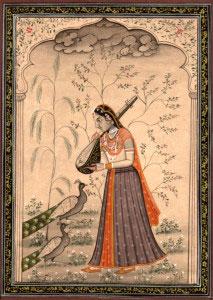Tanpura History
Historical development of the tanpura
Tanpura, tambura and many variations of the name are found in Yugoslavia, Bulgaria and Turkey, throughout North Africa, the Middle East and India. It is not only found as a lute but also as lyres and drums. It is therefore a little difficult to determine exactly which instrument is being discussed when doing research.
So to clarify this confusing situation, I will use the following names. For the North Indian "tanpura", South Indian 'tambura", and the instrumental "tanpuri". The collective name for the instrument, in general, is "tanpura".
There are two main fields of thought concerning the development and growth of the Indian tanpura. Firstly, that the tanpura was a natural development from the indigenous instruments within India itself. Secondly, the fact that the Arab-Persian musicians introduced not only their music but also their instruments, namely the tanbur. I would also like to add that the Indian tanpura is rather special in the sense that it is actually a lute shaped instrument, played as a lyre. In my mind, the tanpura could in fact also be categorized as a lyre. Even though it looks like a lute, its playing technique, stringing and purpose could easily be categorized as a lyre. However, the shape of the modern-day tanpura probably means the instrument did evolve from the tanbur but was influenced by the lyre and the sound from the ancient instruments from the pre-Indus valley times (see chapter on the historical development of Jawari > Origin of Jawari). What stays a mystery, is how this instrument really developed between the Indus valley period up until the 6th century.
The development of the tanpura within India can be followed back to the early stick-zithers. Sculptures from about the 6th and 7th centuries depict long lute players, only it is difficult to determine exactly what kind of instrument they are. They do however imply that the drone was used in one way or another. As far as the flat bridge is concerned (see chapter on the historical development of Jawari), we see that it is possible that as long ago as 2500 BC the basic concept concerning the sound quality of the tanpura i.e. the production of buzz and overtones was known. This was certainly true in the lyre family from Mesopotamia and later Africa.


